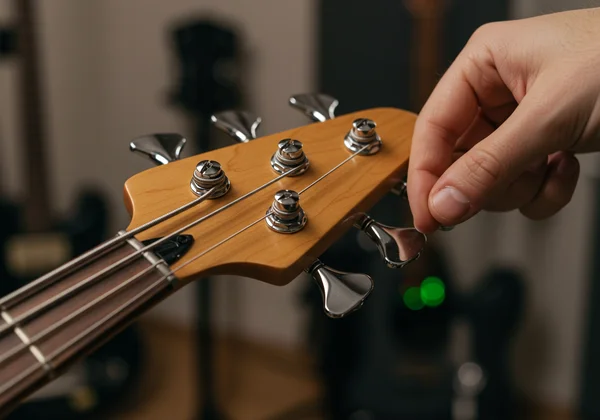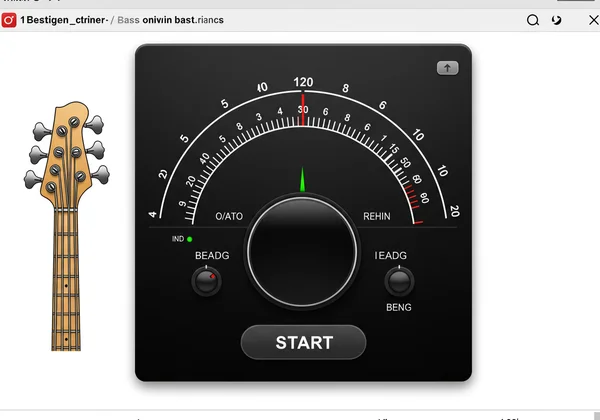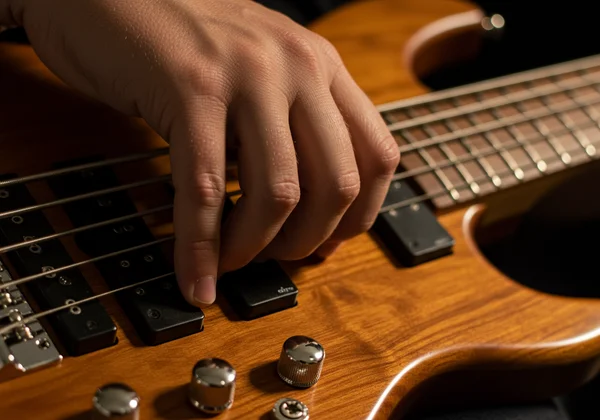Tune Your 5-String Bass with Our Online Bass Tuner: A B-E-A-D-G Guide
Are you the proud owner of a 5-string bass, ready to dive into deeper grooves but finding the extra low B string a bit intimidating to tune? Many bassists, from hobbyists to seasoned players, find extended-range instruments require a slightly different approach. How to tune a 5 string bass? It's a question I hear a lot, and the answer is simpler than you think, especially with the right 5 string bass tuner. This guide will walk you through the standard B-E-A-D-G tuning for your 5-string bass, providing step-by-step instructions using a fantastic free online tuner and crucial tips for accurately taming that powerful low B.
As a bassist who spends hours practicing and recording, I need a tuner that's fast, accurate, and always available. I’ve found that the simple, browser-based tool at Bass Tuner is my go-to solution when I'm at my desk and don't want to plug in my whole pedalboard. It's become an essential part of my daily routine, and I’m confident it will be for you too.

Understanding 5 String Bass Tuning (B-E-A-D-G)
Before we start turning any pegs, it’s essential to understand what we're aiming for. The standard tuning for a 5-string bass adds one lower string to the conventional 4-string setup. This simple addition unlocks a whole new world of low-end power and creative possibilities, but you need to get the foundation right first.
What Are the Standard Notes for a 5-String Bass?
The notes for a 5-string bass, from thickest (lowest pitch) to thinnest (highest pitch), are B-E-A-D-G. Think of it as a standard 4-string bass (E-A-D-G) with an extra low B string added on top. This is the most common and versatile standard tuning configuration, used in genres from metal and jazz to gospel and funk. Memorizing this sequence is the first step toward confident and quick tuning.
The Benefits of a 5-String Bass: Why the Low B Matters
That extra string is more than just a novelty; it’s a game-changer. The low B string provides five extra notes below the standard E, giving you access to a deeper, more resonant extended range. This is perfect for dropping earth-shaking bass lines without needing to change your tuning. It also allows you to play scales and patterns in lower positions on the neck, which can make your playing more efficient and comfortable. When I first switched to a 5-string, I loved being able to play a low C or D without having to down-tune my entire instrument.
The Science of Sound: Frequencies for B-E-A-D-G
Every musical note has a specific frequency, measured in Hertz (Hz). For precise tuning, knowing these values can be helpful. They demonstrate the scientific accuracy that a quality online tuner works toward. Here are the target frequencies for standard 5-string tuning:
- B0: ~30.87 Hz
- E1: ~41.20 Hz
- A1: ~55.00 Hz
- D2: ~73.42 Hz
- G2: ~98.00 Hz
Don't worry, you don't need to memorize these numbers! A good visual tuner, like the one I use, handles the complex calculations. All you need to do is watch the needle and aim for the green light.
Step-by-Step: How to Tune 5 String Bass with Our Online Tuner
Now for the practical part. Grab your 5-string bass, and let's get it perfectly in tune. We'll be using the simple and effective browser-based tool at Bass Tuner. Its dual interface, featuring a visual headstock and a precision dial, makes it ideal for both beginners and experienced players.
Getting Started: Preparing Your Device and Microphone
First things first, you need to set up your environment.
-
Navigate to the Bass Tuner website on your computer or smartphone.
-
The site will ask for microphone access. Click "Allow." This is crucial—the tuner needs to hear your bass to work. Your privacy is respected; the audio is processed in real-time and never stored.
-
Click the "START" button to activate the tuner. You’ll see the needle jump to life, ready to analyze your sound.

Tuning the Low B String: The Foundation
The low B is often the trickiest string. Its low frequency can be challenging for some tuners to pick up clearly, but a quality online tool is designed for this.
- Pluck your thickest string (the low B) firmly but not aggressively.
- Watch the dial on the screen. The needle will tell you if the note is flat (too low) or sharp (too high).
- If the needle is to the left (flat), slowly tighten the tuning peg for that string.
- If the needle is to the right (sharp), slowly loosen the tuning peg.
- Keep plucking and adjusting until the needle is perfectly centered and the indicator turns green.
Tuning E, A, D, and G Strings Accurately
Once the low B is set, the rest of the strings are straightforward. Follow the exact same process for the remaining four strings, aiming for accurate tuning on each.
- Pluck the 4th string and tune it to E.
- Pluck the 3rd string and tune it to A.
- Pluck the 2nd string and tune it to D.
- Pluck the 1st string and tune it to G.
The visual headstock on the tuner is incredibly helpful here. You can click on the specific string you want to tune to help the tool focus, which is a feature I find especially useful in a noisy room.
Double-Checking Your Tuning for Perfect Harmony
After tuning each string individually, it’s good practice to do a final check. Temperature changes and string tension adjustments can slightly affect the other strings. Quickly run through all five strings again, from B to G, making any minor tweaks needed to achieve perfect pitch. Playing the 12th-fret harmonic and the fretted note on each string is another great way to check your intonation.
Mastering the Low B: Tips for the Best Free Online Bass Tuner Experience
Tuning a 5-string presents unique challenges, especially with that floppy low B. Over the years, I've learned a few tricks to get a clean and stable reading every time I use an online bass guitar tuner.
Common Challenges with the Low B String (Buzzing, Slow Response)
Does your low B string cause fret buzz or seem to make the tuner's needle wobble uncontrollably? This is a common issue. The long, slow vibration of a thick string can produce complex overtones that confuse less-sensitive tuners. This is why a tool built with modern web audio technology makes a huge difference. It can better isolate the fundamental frequency for a stable reading.
Playing Techniques for a Clear Tuner Reading
How you pluck the string matters. To get the best results from any tuner, follow these tips:
-
Use Your Thumb or the Fleshy Part of Your Finger: A pick or an aggressive fingerstyle pluck can create harsh transients and overtones. A softer touch produces a purer, more fundamental note.
-
Pluck Near the Bridge: Plucking closer to the bridge produces a tighter sound with fewer overtones, making it easier for the tuner to read.
-
Mute Other Strings: Let only the string you are tuning ring out. Use your other fingers to gently mute the remaining strings to prevent sympathetic vibrations from confusing the tuner.

When to Consider String Gauge or Professional Setup
If your low B string consistently sounds muddy, buzzy, or won't stay in tune, the problem might be physical. A "floppy" B string can often be fixed by switching to a heavier string gauge (e.g., a .130 or .135). If you're still having issues, it might be time for a professional setup. A luthier can adjust the action, intonation, and truss rod to ensure your bass plays perfectly.
Your Journey to a Perfectly Tuned 5-String Bass
Tuning your 5-string bass doesn't have to be a chore. By understanding the fundamentals of B-E-A-D-G tuning and using a reliable, accessible tool, you can ensure your instrument is always ready to lay down a solid foundation. The convenience of a high-quality online tuner removes the barriers, letting you get in tune in seconds, whether you're at home, in the studio, or warming up backstage.
Ready to get that low B sounding perfect? Give your bass the accurate tuning it deserves. Head over to the homepage and start tuning now.
Frequently Asked Questions About 5-String Bass Tuning
What is the standard string order on a 5-string bass?
The standard string order for a 5-string bass, from lowest pitch to highest, is B, E, A, D, G. The thickest string is B, and the thinnest string is G.
Can an online tuner accurately tune my low B string?
Absolutely. Modern online tuners built with advanced Web Audio APIs are highly sensitive and can accurately detect low frequencies like a bass's B string. The key is to provide a clear signal by following the plucking techniques mentioned above. I've found that this online tool is especially reliable for locking onto my low B without any flutter.
Why does my low B string sound muddy or buzz?
A muddy or buzzing low B string can be caused by several factors. The most common culprits are old or worn-out strings, a string gauge that is too light for the bass's scale length, or an improper setup (e.g., the action is too low). Start by changing your strings, and if the problem persists, consider a professional setup.
How often should I tune my 5-string bass?
You should tune your bass every single time you pick it up to play. Even minor changes in temperature and humidity can cause the wood and metal components of your instrument to expand or contract, affecting the string tension and pitch. Making tuning the first step of every practice session is a habit that will serve you well.